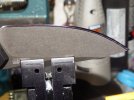For my guided sharpener .1 degree is the most difference between stones I can have without it affecting my sharpening with coarser stones, with the finer ones it may be noticeable, depending on the width of the bevel. IMO the whole point of using a guided sharpener is repeatability. If your angles repeat perfectly all you need to do is remove the scratches from the last stone, if they don't repeat then you need to set the bevel as well which takes a lot more passes to achieve.
-
The BladeForums.com 2024 Traditional Knife is ready to order! See this thread for details: https://www.bladeforums.com/threads/bladeforums-2024-traditional-knife.2003187/
Price is$300$250 ea (shipped within CONUS). If you live outside the US, I will contact you after your order for extra shipping charges.
Order here: https://www.bladeforums.com/help/2024-traditional/ - Order as many as you like, we have plenty.
You are using an out of date browser. It may not display this or other websites correctly.
You should upgrade or use an alternative browser.
You should upgrade or use an alternative browser.
Sharpening Angle: How Much Deviation is Significant?
- Thread starter PeteCress
- Start date
I think that's apples and oranges, though. You're talking about variation that occurs on the same bevel due to inconsistent stone thickness, whereas the OP was talking about variation in angle from one side of the blade to the other. As long as the A/B variation is constant, it shouldn't have any effect on sharpness.For my guided sharpener .1 degree is the most difference between stones I can have without it affecting my sharpening with coarser stones, with the finer ones it may be noticeable, depending on the width of the bevel. IMO the whole point of using a guided sharpener is repeatability. If your angles repeat perfectly all you need to do is remove the scratches from the last stone, if they don't repeat then you need to set the bevel as well which takes a lot more passes to achieve.
- Joined
- Mar 28, 2020
- Messages
- 6,427
...the stars shine brighter at night, the air smells fresher, and the universe is right again.
That's the way I feel looking at my perfect Wicked Edge sharpened edge bevels.
They're only going to be as perfect as the blade grind, though, so ... usually not so perfect.That's the way I feel looking at my perfect Wicked Edge sharpened edge bevels.
- Joined
- Mar 28, 2020
- Messages
- 6,427
On my Ruxin Pro 008, I can adjust the sharpening angle to exactly 17⁰.
But when I flip the knife over, the angle may change to 16.8⁰.
"May" because if I lay the weight of my hand on the stone the angle may change to something like 17.1⁰ and sometimes even stay there after the hand is removed.
Even moving the stone from the center of the blade to near the tip can change the angle by a few tenths of a degree.
I have watched the YouTube vid about changing the angle diff by adding layers of tape under the clamp jaws.
But I keep coming back to wondering:
- How much angle variation is significant - especially given the typical .1⁰ accuracy of most digital angle indicators.
- Whether more expensive sharpening jigs with independent clamps have similar variations when the knife is flipped 180⁰.
You don't have to flip the knife with a Wicked Edge sharpener system. I use an angle cube and try to keep the bevel angles perfect.
- Joined
- Mar 28, 2020
- Messages
- 6,427
Well as close to perfect as possible.They're only going to be as perfect as the blade grind, though, so ... usually not so perfect.
Right, but if the grind isn't symmetrical, you'll have different size bevels even if you use identical angles on each side. You also can't compensate for the curvature of the blade.You don't have to flip the knife with a Wicked Edge sharpener system. I use an angle cube and try to keep the bevel angles perfect.
- Joined
- Mar 28, 2020
- Messages
- 6,427
Yes, you can. For different size bevels you just reprofile the bevels to match them up. For blades with some curvature, you clamp the blade so that the bevel is even all the way down. That's called the "sweet spot".Right, but if the grind isn't symmetrical, you'll have different size bevels even if you use identical angles on each side. You also can't compensate for the curvature of the blade.
Some people grind blades with asymmetrical bevels on purpose.
In this photo you can see how the stone removed some of the sharpie on my Kershaw Launch 1 using my Wicked Edge WE66 Obsidian. The edge bevels on it are 17dps, and the mark on the sharpie is 12dps.

- Joined
- Jul 3, 2019
- Messages
- 14,799
People have said as much already, but i don’t know how a fella could measure a dependable 1 degree increment on something so small as a bevel, much less a tenth. As you’ve observed, there’s play in the system, which is true for every device to varying degrees (no pun intended).
Don’t let numbers fool you into thinking you have greater accuracy or precision than you do. Chase the perfection dragon only as far as what won’t drive you nuts.
Don’t let numbers fool you into thinking you have greater accuracy or precision than you do. Chase the perfection dragon only as far as what won’t drive you nuts.
No, the Op states that his angles change by a few tenths of a degree depending on the pressure on the stone.I think that's apples and oranges, though. You're talking about variation that occurs on the same bevel due to inconsistent stone thickness, whereas the OP was talking about variation in angle from one side of the blade to the other. As long as the A/B variation is constant, it shouldn't have any effect on sharpness.
